The best electric guitar for shredding can accommodate the fast, intricate, and often highly technical lead guitar playing that modern virtuosos demand.
Shredding has its roots in heavy metal and hard rock music, but can also be prominent in jazz fusion, progressive rock, and neoclassical music. Guitarists such as Steve Vai, Joe Satriani, and Eddie Van Halen, are celebrated shredders with a high degree of musicality.
Manufacturers know that there is demand for guitars specifically for shredding, and the market is full of options for different preferences. With so many options out there, it may be overwhelming to pick one. But we are here to help. Keep reading.
Read more about our review process.
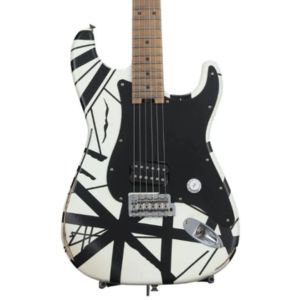
EVH Striped Series '78 Eruption
Features: Wheel truss rod adjustment, Satin urethane neck finish, EVH Wolfgang bridge humbucker
Benefits: Super fast neck, Screaming tones, Easily set up to players preference
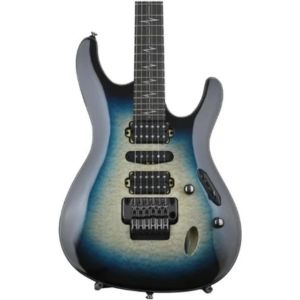
Ibanez Nita Strauss Signature JIVAJR
Features: Wizard II neck, Ebony fretboard, Quantum HSH pickups
Benefits: Massive tonal range, lightning fast playability, Super smooth feel
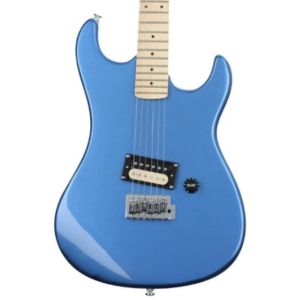
Kramer Baretta Special
Features: Open coil zebra humbucker, Smooth maple neck, Tremolo bridge
Benefits: Beginner friendly playability, Great tuning stability, Simple control layout
Contents
Our Top 3
The Ibanez Nita Strauss Signature JIVAJR is our top choice. It features a resonant meranti body and comes in a nicely stylized and ergonomic super-strat type of design. With a quilted maple top, Deep Sea Blonde color, and a Satin finish, this guitar has a striking and very appealing look to match great tone and playability.
The Kramer Baretta Special is our Budget Choice. Ideal for beginners, this guitar features a “zebra” humbucker on a pretty Candy Blue mahogany body. It delivers a good tone and feel for those starting out.
The EVH Striped Series ’78 Eruption is our Editor’s Choice. This guitar is great for dedicated players that indulge in shredding and features a basswood body and a slanted EVH Wolfgang Humbucker on the bridge position. With superior tone and playability, it captures the spirit of Eddie Van Halen’s 1978 guitar.
Individual Reviews

Ibanez Nita Strauss Signature JIVAJR
A fantastic instrument made for a certified shredder.
From Alice Cooper to Demi Lovato, virtuoso Nita Strauss has become one of the most in-demand shredders in today's industry. The JIVAJR is the more affordable version of her signature guitar and comes with a fast neck and killer tone made by Ibanez to Strauss' specifications.
The Ibanez Nita Strauss Signature JIVAJR comes with a resonant meranti body, in a stylized and ergonomic super-strat body. With a quilted maple top, beautiful Deep Sea Blonde color, and a Satin finish, this guitar has a striking and very appealing look.
We plugged into our Marshall combo to try out this guitar and relied on our EHX Big Muff Pi and Ibanez Tube Screamer for distortion. The Quantum Ceramic humbucker at the bridge position gave us fat distortion that was also penetrating. Perfect for riffing, power chords, and solos, this pickup delivered nice sustain and good note definition.
In the middle position, we’ve got an Alnico Quantum single-coil, which makes this guitar versatile. Here we got that typical present and bright single coil tone, which we liked best with a bit of overdrive and for clean playing with a bit of reverb.
Finally, the neck position also comes outfitted with a Quantum Ceramic humbucker. Here the tone is a bit warmer and not as aggressive as in the bridge position. Although it did sound good for chords and riffing, we liked it best for soloing over spacier melodies or lines, as it had nice sustain and tone.
This guitar felt really good in our hands, and we were able to fly up and down the smooth ebony fingerboard. With a comfortable third-generation Wizard III neck profile, 15.7″ radius, a scale length of 25.5″ and a nut width of 1.692″, the JIVAJR was a joy to play.
This guitar also performed well when we tried dive bombs and other aggressive uses of the whammy bar. With an Edge-Zero II tremolo, our intonation remained stable throughout our tests. In short, a fantastic guitar that delivers great tone and a fast-playing neck.
Verdict: The Ibanez Nita Strauss Signature JIVAJR features a meranti body, and a stylish super-strat design. Add to that a quilted maple top, a fast neck, and a punchy tone with sustain, and you’ve got yourself a shredder’s guitar, with the specifications of Nita Strauss herself.

Kramer Baretta Special
An affordable choice for folks starting out.
Legends like Neal Schon and Richie Sambora have relied on Kramer for both recordings and live shows. This model is an excellent option for beginners that need a good guitar that is also affordable.
The Kramer Baretta Special delivers playability and tone that are good for the beginner. Featuring a “zebra” humbucker and a stylized and modern-looking mahogany body, this guitar lives up to the Kramer name by providing good features for the price.
The Kramer Baretta is a simple instrument that comes with just one pickup, a humbucker with Alnico V magnets at the bridge position. From the start, it was clear that this guitar was made for rock and metal, and so we plugged into our Marshall combo and paired it up with our Big Muff Pi distortion pedal.
The sound of this guitar is aggressive and bright, as we’d expect from the bridge position pickup. On clean, the sound had a good presence and will be great to get you started on open chords. It also sounded good with rhythm parts, or to work out a few simple lines and riffs.
When paired with our Big Muff Pi, we got powerful distortion, good for power chords, riffs, and solos. We also were able to dial in some good overdriven tones that can work nicely for both power ballads and blues solos.
This guitar felt good in our hands, with a comfortable 12″ radius. With a fingerboard made of maple, 22 medium jumbo frets, a scale length of 25.5″, and a nut width of 1.679, this guitar was fun to play. It is a great instrument to learn on, especially for those that gravitate towards rock and shredding guitar.
With Kramer Deluxe die-cast tuning heads and a Kramer Traditional tremolo bridge, this guitar comes with good features for the price. In short, a good instrument for beginners that need a reliable guitar to start on.
Verdict: The Kramer Baretta Special comes with a single humbucker pickup and a good-looking Candy Blue mahogany body. This is a good guitar for beginners that need an affordable instrument that delivers good tone and playability.

EVH Striped Series '78 Eruption
A superior guitar made for the ultimate shredder.
The Frankestein was Van Halen's primary instrument from 1977 to 1983, and went through several modifications through the years, all envisioned by the master himself. This instrument is a replica of Van Halen's main guitar on its earliest incarnations, specifically from the Eruption era.
The EVH Striped Series ’78 Eruption features a basswood body and a slanted EVH Wolfgang Humbucker on the bridge position. Inspired by Eddie Van Halen’s Frankenstrat, this guitar captures the spirit, tone and playability of the original.
When Van Halen built his original Frankenstrat, he was attempting to merge the sound of a classic Gibson with the physical characteristics of a Fender. And that’s exactly what it felt like when we plugged the EVH Striped Series ’78 Eruption into our Marshall combo amp.
With our Tube Screamer dialed in at high distortion settings, we got a scorching, penetrating tone that had great string definition. Everything from power chords, fast riffs, and legato runs sounded well-balanced and with great presence.
This guitar is also outfitted with a 500 k EVH Bourns low-friction volume pot, which allows us to perform smooth swells with no clicks or pops. The volume opens up smoothly and there are no bumps or unwanted surprises.
We also loved the fantastic playability of this instrument. The ’78 Eruption comes with a Relic’d quartersawn maple neck and hand-rubbed satin urethane back finish for ultimate comfort. With a 12″ to 16″ compound-radius maple fingerboard, and a scale length of 25.5″, we got a Fender feel on a fast-playing neck that was quite smooth.
Verdict: The EVH Striped Series ’78 Eruption is a replica of Van Halen’s Frankenstein guitar on its early version, and features the tone and playability that the master preferred around 1978. Featuring a basswood body and a slanted EVH Wolfgang Humbucker on the bridge position this guitar is for discerning players that want fantastic tone and playability, with a touch of history.
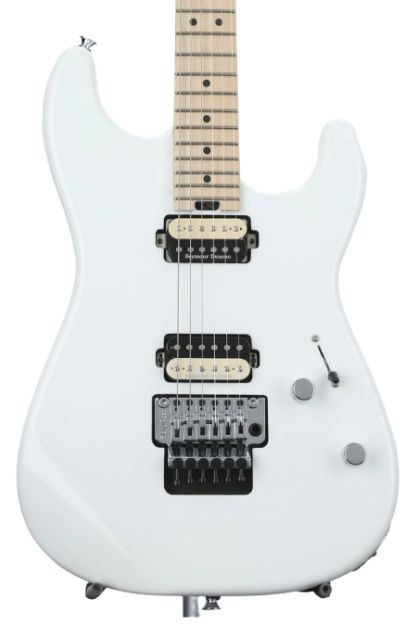
Charvel Pro-Mod San Dimas Style 1 HH
A fast-playing guitar with scorching Seymour Duncan's.
Charvel is well-known for building fast-playing guitars that produce good tones and excellent value. The San Dimas Style 1 HH is a great example of that and provides players with good playability, tone and sustain at a fair price.
The Charvel Pro-Mod San Dimas Style 1 HH features an alder body and comes in an elegant Snow White color Gloss Polyurethane. With a Recessed Floyd Rose and comfortable neck, this guitar is a good choice for shredders that like an aggressive Seymour Duncan pickup tone.
This Charvel features a Seymour Duncan SH1N ’59 Humbucker on the neck and a Seymour Duncan JB TB4 Humbucker for the bridge position. When distorted via our EHX Big Muff Pi, the neck pickup gave us an aggressive but well-defined punch that is great for rock and metal.
Both power chords and leads had a forward character to them and will likely cut through a busy mix, live or in the studio.
On the other hand, the neck pickup gave us a rounder tone that was a bit more tamed. We liked it for modern rock to metal but preferred how it paired up with our Ibanez Tube Screamer.
We also liked how this guitar felt in our hands, with a compound-radius maple fretboard that flattens out from 12 inches to 16 inches as you move up to the higher frets. The neck is made of 2-piece maple and features a graphite reinforcement. With a scale length of 25.5″, we really liked how comfortable this neck was, with great low action that allows for speed.
In short, a Charvel guitar that lives up to this company’s reputation. This is a good instrument with modern traits and nice playability.
Verdict: The Charvel Pro-Mod San Dimas Style 1 HH is a good choice for shredders that want a nice tone and playability at a fair price. With an alder body and an aggressive Seymour Duncan pickup tone in both the neck and bridge positions, this guitar delivers.
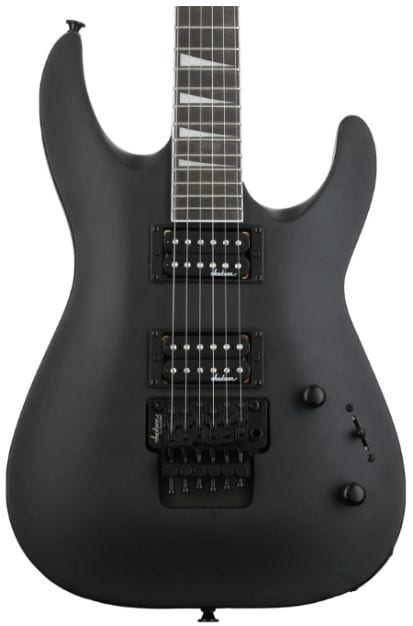
Jackson Dinky Arch Top JS32 DKA
A metal shredder's machine.
Jackson has a stellar reputation as a brand, and one of its niches is fast-playing guitars for rock and metal. The JS32 DKA follows in those footsteps by providing an aggressive tone and comfortable playability, on a very affordable instrument.
The Jackson Dinky Arch Top JS32 DKA is a solid body guitar that comes with a poplar body on a dark satin black color. We plugged this guitar into our Marshall combo to conduct our tests, starting with the bridge position Jackson High-output humbucker.
With the tone knob around five, and our Electro Harmonix Big Muff Pi at a pronounced distortion setting, we got a bright and aggressive tone from the bridge pickup. The sound was a good option for playing metal or similar styles, as our power chords, riffs, and solos had that in-your-face quality that these harder styles of music require.
Moving on to the neck pickup, also a Jackson High-output humbucker, we got an aggressive sound that was a bit rounder and not as bright. This pickup can be used to play hard rock and other similar styles and does a good job for spacious solos that require a warmer character.
Playability on this guitar is exactly what you’d expect from a shedder’s instrument. The JS32 Dinky comes with a 12-inch to 16-inch compound radius that gave us a good grip for fretting chords and speed on the higher frets. With an amaranth fingerboard that displays traditional Jackson shark fin inlays and a scale length of 25.5,” this neck combines modern playability with the traditional Fender scale length.
You also get a nut width of 1.6875″ and 24 frets, making this Jackson Dinky Arch Top a good choice for metal players. The tremolo system is a Jackson Licensed Floyd Rose, so you can also get started on dive bombs and other pyrotechnics.
Naturally, to keep the price of this guitar low, sustain and tuning stability is not ideal. That said, this is a very good instrument for beginners interested in shredding.
Verdict: The Jackson Dinky Arch Top JS32 DKA comes with the tone, feel, and attitude perfect for beginner metal players. This guitar features two Jackson High-output humbuckers and a compound radius for greater comfort across the neck.
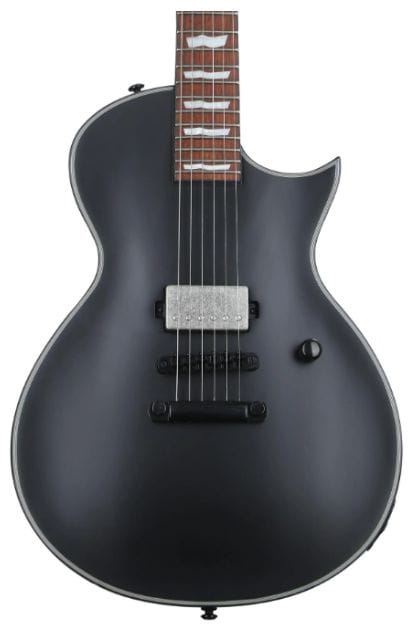
ESP LTD EC-201 E
Good tone and playability with outstanding stability.
ESP is a well-known brand among rock and metal players, and its LTD line is very popular among guitarists. The EC-201 E has a Gibson Les Paul feel to it, particularly on the playability aspect, but comes at a much more affordable price and delivers a scorching hot distorted tone in its humbucker pickup on the bridge position.
The ESP LTD EC-201 E features a resonant mahogany body and comes with a humbucker on the bridge position as the only pickup on the guitar. However, you also get coil-splitting via a push-pull knob in order to give you both single-coil and humbucker tones. We tried it going into our Vox AC 30 amp and used our Ibanez Tube Screamer and EHX Big Muff for distortion.
The first thing that we liked about this guitar was its playability. With a set-in 3-piece mahogany Thin-U neck, we felt very comfortable across the entire Roasted Jatoba fingerboard. This guitar features a 13.7″ which was comfortable for us but may be too thin for folks with bigger hands or those that prefer thicker necks.
The LTD EC-201 comes with a Gibson-like 24.75″ scale length, and a nut width of 1.653″. Although we liked how it felt, some shredders may prefer a compound neck or a faster-playing fretboard.
Regarding stability, the Tune-O-Matic bridge with a stop bar tailpiece (also a Gibson-like trait) kept our tuning very consistent, which is always a good thing. Although you sacrifice the ability to have a whammy bar, you do get stellar stability with this fixed bridge.
Soundwise, the ESP Designed LH-150B Humbucker gave us a hot output that was aggressive but with great string definition. We really liked the sound on everything from power chords to single lines and double stops, and it matched nicely with both our Tube Screamer and Big Muff pedals.
In short, a good guitar for folks that gravitate toward rock and metal but like the more traditional feel of a Gibson guitar.
Verdict: The ESP LTD EC-201 E comes with a resonant mahogany body and a humbucker on the bridge position. With a push-pull knob that gives you single-coil and humbucking tones, this guitar delivers great distorted tones.
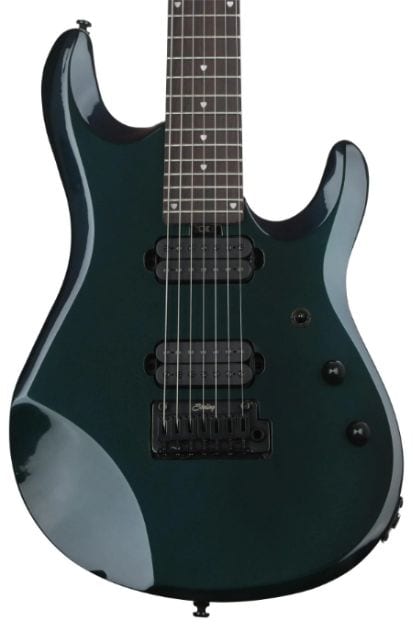
Sterling By Music Man 7-string John Petrucci Signature JP70
Tone and playability from Dream Theater's virtuoso guitarist.
John Petrucci is one of the greatest shredders to emerge in the last 30 years, and this 7-string guitar features some of the virtuoso's guitar traits. With modern appointments, this guitar gives you tone and playability that the Dream Theater guitarist would approve of, in a budget friendly version.
The Sterling By Music Man 7-string John Petrucci Signature JP70 features a nyatoh body with Sterling by Music Man Humbuckers on both the neck and bridge position. This guitar is essentially a more affordable version of John Petrucci’s original instrument and we were very excited to plug it into our Marshall combo amp for our tests.
We got a high output tone at the bridge pickup, perfect for distorted power chords and riffs, all of which had a nice definition. This pickup was our favorite as it gave us a nice growl with good note separation.
The neck pickup gave us a rounder tone, still aggressive but with less edge than what we got at the neck position. This tone was good for everything from rock all the way to blues and even saturated fusion.
Playability on this instrument is good, and fast passages came through nicely. This Sterling by Music Mac guitar comes with a hard maple neck and responsive rosewood fingerboard. We also liked the feel of the 24 medium jumbo frets, 16-inch fingerboard radius, and familiar 25.5-inch scale.
In short, a nice guitar for folks that gravitate towards progressive rock. Naturally, it does not have the high-end features of Petrucci’s original, but it is far more affordable.
Verdict: The Sterling By Music Man 7-string John Petrucci Signature JP70 comes with a nyatoh body and high output humbuckers at the neck and bridge position. A more affordable version of John Petrucci’s instrument, it maintains some of the original features and the overall vibe.
How To Choose The Right Guitar For You
In order to shred (play burning-fast scales, arpeggios, and other high-speed patterns), you need a guitar that can respond well to these demands. Naturally, the most important thing is practicing with steadfast dedication, as no guitar will make you sound good if you don’t work at it.
That said, high-speed playing and other techniques common to shredding such as tapping and sweeping can benefit from particular types of guitars. Often, the most important aspect of a guitar for shredding is the neck and fretboard, as they will determine how “fast” the playability on a guitar is.
Fast-playing neck
Having a fast-playing neck and fretboard can make a massive difference for shredding. But what exactly is a fast-playing neck?
Although this is a subjective topic, a fast-playing neck allows for quick and easy movement of the fingers across the fretboard, especially when playing lead or solo passages.
Some key factors must be taken into consideration.
Neck Shape
The shape of the neck can have a significant impact on how fast it feels to play. A thinner neck with a flatter radius will typically feel faster than a thicker neck with a more rounded radius. This is because the fingers have less distance to travel between frets on a flatter fretboard. As you’d expect, shredding guitars often feature thinner necks.
Action
Action refers to how much distance is between the string and the fret. This distance makes a difference in how long it takes the player to press the string in order to produce sound. A lower action can make it easier to play fast, as the strings require less pressure to fret. However, if the action is excessively low, it can result in buzzing or other unwanted noise.
Finish
The finish of the neck and fretboard can also affect how fast it feels to play. A satin or unfinished neck tends to provide a smoother feel with less friction, which some players prefer for fast playing. That said, the best finish on the neck and fretboard is also another area of contested debate among guitar players.
High Output Pickups
Pickups are another important consideration for shredding guitars. And shredders tend to prefer high-output pickups. These pickups are designed to produce a strong and dynamic tone that is ideal for fast and technical playing styles.
High-output pickups can produce a clear and defined tone, even when playing at high speeds. This allows the player to produce a clear and articulate sound, even when playing fast and intricate runs, which are typical in shredding.
Another advantage of high-output pickups is their ability to handle high-gain settings without producing unwanted noise or feedback. This is particularly important for shredders who often rely on high-gain settings to achieve their signature sound. In order to produce a thick and powerful tone that can cut through even the most intense distortion and provide clarity and definition to the player’s sound, high-output pickups are often employed.
Humbuckers vs single coil
Although there are some single coils pickups with high-output, humbuckers are renowned for producing higher output than single coils. In other words, high-output pickups for shredding are typically humbuckers, which provide a thicker and more powerful sound compared to single-coil pickups.
They are also often equipped with a ceramic magnet, which produces a more aggressive and focused tone compared to an Alnico magnet.
When selecting high-output pickups for shredding, it is important to consider the type of music that will be played and your personal preferences. For instance, a pair of pickups for jazz fusion will likely be different from those used for metal.
Final Thoughts
The best guitars for shredding facilitate playing and offer powerful and articulate sound even when playing fast parts.
To recap our choices, the Ibanez Nita Strauss Signature JIVAJR is our top choice. It features a resonant meranti body and comes in a nicely stylized and ergonomic super-strat type of design. With a quilted maple top, Deep Sea Blonde color, and a Satin finish, this guitar has a striking and very appealing look to match great tone and playability.
The Kramer Baretta Special is our Budget Choice. Ideal for beginners, this guitar features a “zebra” humbucker on a pretty Candy Blue mahogany body. It delivers a good tone and feel for those starting out.
The EVH Striped Series ’78 Eruption is our Editor’s Choice. This guitar is great for dedicated players that indulge in shredding and features a basswood body and a slanted EVH Wolfgang Humbucker on the bridge position. With superior tone and playability, it captures the spirit of Eddie Van Halen’s 1978 guitar.


